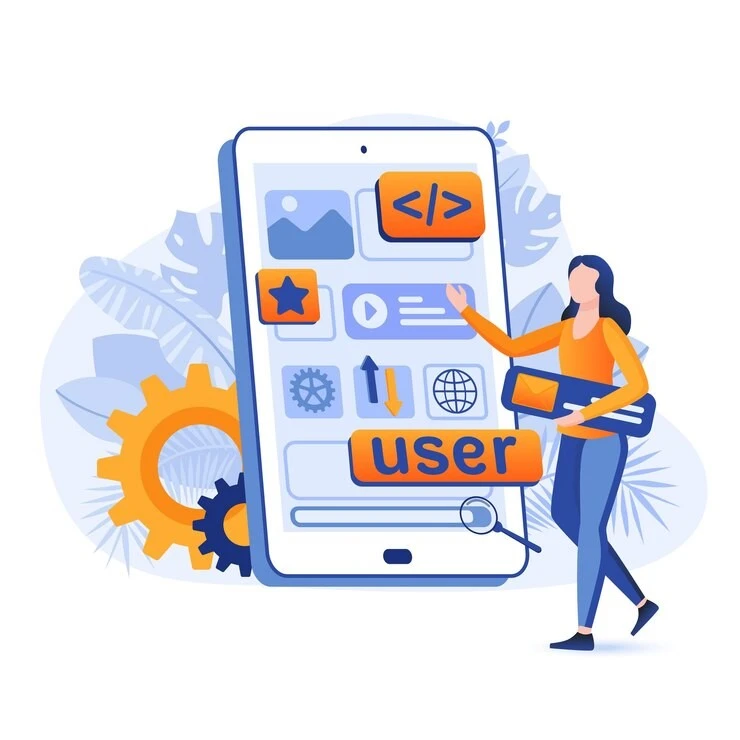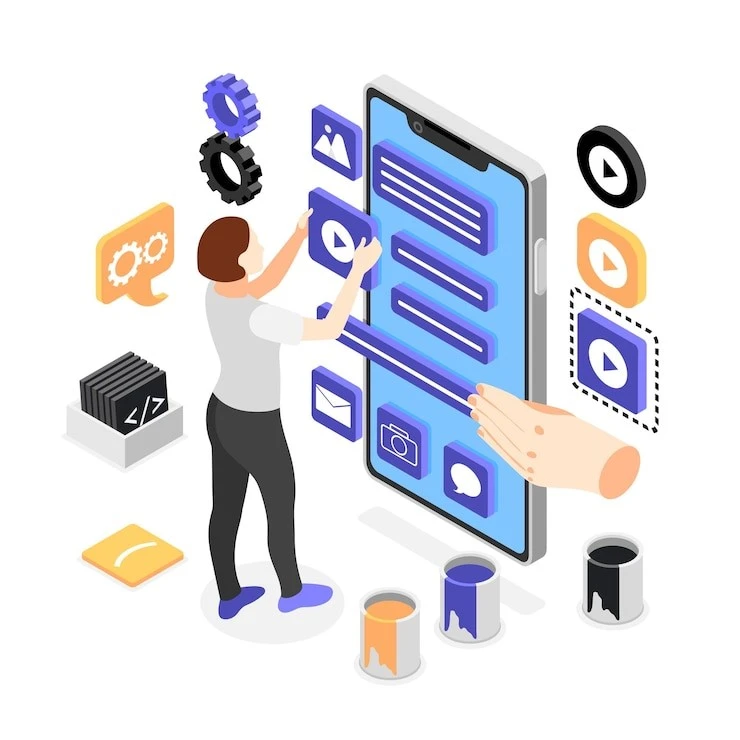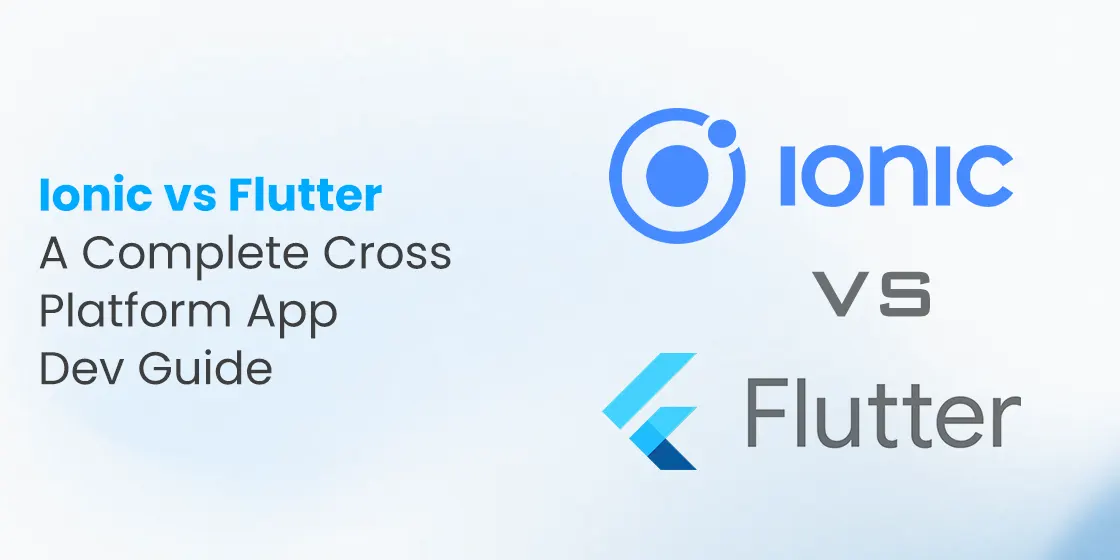Table of Content
Discover the Differences Between Ionic vs Flutter, Two Popular App Platforms
The mobile app development landscape has reached a critical inflection point in 2025, with cross-platform frameworks becoming the dominant force in how applications are built and deployed. According to recent industry data, global mobile app revenues are projected to reach $935 billion by 2025, making the choice between development frameworks a strategic business decision that extends far beyond mere technical preferences.
What makes the Ionic vs Flutter comparison particularly fascinating is how these two frameworks approach the same fundamental challenge—creating high-quality applications that work seamlessly across multiple platforms—through completely different technological philosophies. While 67% of developers reported using cross-platform tools for app development in 2024, the choice between these specific frameworks often determines not just the immediate project outcome, but the long-term scalability and maintainability of your application ecosystem.
This comprehensive analysis will explore every critical aspect of this decision, from performance benchmarks and development workflows to community support and future-proofing considerations. Whether you’re a startup founder evaluating your technical stack or a mobile app development service looking for your next initiative, this will enable you to make an informed decision.
Understanding the Fundamental Differences: Architecture and Philosophy

The Ionic vs Flutter comparison begins with understanding their fundamentally different architectural approaches to cross-platform development. Flutter, released by Google in 2017, operates as a comprehensive UI toolkit that uses its own rendering engine built on the Skia graphics library. This approach means Flutter applications compile directly to native machine code for each target platform, bypassing the need for native UI components entirely and instead drawing every pixel on the screen through its custom rendering system.
In contrast, Ionic takes a web-first approach that leverages existing web technologies and standards. Built on HTML, CSS, and JavaScript, Ionic applications essentially run as sophisticated web applications within a native container called a WebView. This hybrid approach allows developers to use familiar web development tools and techniques while still accessing native device features through plugins and bridges provided by Capacitor or Cordova.
The philosophical divide between these two cross-platform development frameworks extends beyond mere technical implementation to represent two distinct visions of how cross-platform development should evolve. Flutter advocates for a “write once, run anywhere” methodology through a self-contained ecosystem that prioritizes performance and visual consistency. Ionic champions the “embrace web standards” philosophy, betting on the long-term viability and universality of web technologies as the foundation for multi-platform applications.
Looking for an experienced development team to manage your software projects? Get in touch with us now and hire skilled teams for your project.
Build My TeamPerformance Analysis: Native Compilation vs Web Technologies
Performance represents one of the most critical factors in the Ionic vs Flutter evaluation, with each framework’s architectural choices directly impacting application speed, responsiveness, and user experience. Flutter’s compilation to native machine code provides significant performance advantages, particularly for graphics-intensive applications and complex animations. Tests consistently show Flutter apps running at 60 FPS with smooth animations and faster response times compared to hybrid alternatives.
The performance benefits of Flutter become most apparent in scenarios involving heavy graphics processing, complex UI animations, or real-time data manipulation. Flutter’s Skia rendering engine gives developers complete control over every pixel, enabling sophisticated visual effects and smooth transitions that rival native applications. This direct-to-metal approach eliminates the performance overhead typically associated with bridge-based cross-platform solutions.
However, the Ionic vs Flutter performance comparison isn’t uniformly favorable to Flutter across all use cases. Ionic applications excel in scenarios where web-based content delivery and integration with existing web services are priorities. For business applications, content-driven apps, and scenarios where rapid prototyping and deployment matter more than peak performance, Ionic’s approach can be more practical and cost-effective.
Let’s do a comparative analysis of two of the world’s top software development frameworks used today.
Development Experience and Learning Curves

The developer experience represents a crucial differentiator in the Ionic vs Flutter decision, as it directly impacts team productivity, project timelines, and long-term maintenance costs. Flutter requires developers to learn Dart, Google’s programming language that, while approachable, is familiar to less than 2% of developers according to recent surveys. However, developers who invest time in learning Dart often report high satisfaction with Flutter’s development workflow, particularly the hot reload feature that enables real-time code changes without application restarts.
The tooling ecosystem also differs substantially between Ionic vs Flutter approaches. Flutter developers work within a more uniform, Google-designed environment with excellent debugging tools, comprehensive documentation, and strong IDE support through Android Studio and VS Code extensions. The consistency of this experience can be beneficial for maintaining code quality and reducing development friction across team members.
Ionic developers benefit from the vast ecosystem of web development tools, including Chrome DevTools for debugging, extensive npm package libraries, and integration with popular web frameworks. This familiarity can reduce cognitive load for web developers transitioning to mobile development, though it may also introduce complexity when dealing with mobile-specific considerations like device capabilities and platform differences.
Code Reusability and Multi-Platform Support
Code reusability stands as one of the top SaaS trends and primary motivations for choosing cross-platform frameworks, making it a critical factor in the Ionic vs Flutter evaluation. Flutter’s “write once, run anywhere” philosophy delivers impressive code reuse statistics, with companies like Google reporting over 90% code reuse across iOS, Android, web, and desktop applications. This high reusability stems from Flutter’s unified rendering approach and comprehensive widget library that maintains consistency across all target platforms.
Flutter’s multi-platform support has expanded significantly since its initial mobile focus, now encompassing web, macOS, Windows, and Linux platforms. However, Flutter’s web support, while functional, doesn’t always match the performance and SEO capabilities of traditional web applications. Organizations planning significant web deployments may find Flutter’s web output less optimal compared to dedicated web technologies.
Ionic’s strength in multi-platform deployment lies in its native web foundation, making it exceptionally well-suited for Progressive Web Applications (PWAs) and scenarios where web and mobile applications need to share substantial functionality. The ability to deploy the same codebase as both a mobile application and a web application provides unique strategic advantages for certain business models and user acquisition strategies.
Community Support and Ecosystem Maturity

The vitality and maturity of each framework’s ecosystem significantly impact long-term project success, making community support a crucial factor in the Ionic vs Flutter decision. Flutter has experienced extraordinary growth since its official launch, with Google’s substantial investment driving active community development. As of early 2025, Stack Overflow reports over 250,000 Flutter-related questions, and GitHub shows more than 15,000 Flutter packages available through the pub.dev repository.
Flutter’s community benefits from Google’s strategic commitment and regular updates, with major releases introducing new capabilities and platform support. The framework enjoys active participation from global meetups, conferences, and online forums, creating a robust knowledge-sharing environment. However, Flutter’s relative youth means that some specialized use cases or enterprise integrations may have less mature solution sets compared to more established frameworks.
The commercial support landscape differs between frameworks, with Ionic offering enterprise support packages and professional services through Ionic Enterprise, while Flutter relies more heavily on Google’s documentation and community support. For organizations requiring guaranteed support levels or enterprise-specific features, these commercial considerations may influence framework selection.
Performance Benchmarks and Real-World Applications
Real-world performance data provides crucial insights for the Ionic vs Flutter decision, with testing revealing significant differences in various application scenarios. Flutter consistently demonstrates superior performance in graphics-intensive applications, with benchmark tests showing frame rates maintaining 60 FPS even during complex animations and transitions. The direct compilation to native code eliminates interpreter overhead, resulting in faster execution times for computational tasks and smoother user interactions.
However, Ionic vs Flutter performance comparisons must consider the complete application lifecycle, including factors like initial load times, memory usage, and battery consumption. While Flutter applications may perform better during intensive operations, Ionic applications often demonstrate smaller initial download sizes and faster startup times for content-driven applications. Ionic’s Hello World application measures approximately 3.2MB, while Flutter’s equivalent weighs in at 7.5MB due to the inclusion of the Flutter runtime.
However, the real competition is between React, Ionic, and Flutter, with all three claiming themselves the victor.
Cost Analysis and Development Timeline Considerations

The economic implications of the Ionic vs Flutter choice extend beyond initial development costs to encompass long-term maintenance, team scaling, and platform evolution considerations. Organizations with existing web development teams often find Ionic provides faster time-to-market due to skill reusability and reduced learning curves. The ability to leverage existing web developers without extensive retraining can result in 30-40% faster initial deployment times according to industry research.
Flutter’s initial learning investment in Dart and framework-specific concepts may increase early project costs, but organizations often report improved long-term productivity once teams become proficient. The consistency of Flutter’s development environment and reduced platform-specific code can lead to lower maintenance costs and more predictable development timelines for complex applications.
Hiring considerations represent another crucial cost factor, with JavaScript and web technology skills commanding broader market availability and potentially lower rates compared to specialized Flutter developers. However, the growing popularity of Flutter has improved developer availability, while the specialization may command premium rates in competitive markets.
Frequently Asked Questions
| Which framework is better for beginners: Ionic or Flutter? For developers with web development experience, Ionic typically offers an easier learning curve since it uses familiar technologies like HTML, CSS, and JavaScript. You can leverage existing skills in frameworks like Angular, React, or Vue.js immediately. Flutter requires learning Dart, which is relatively straightforward but represents an additional learning investment. However, Flutter’s comprehensive documentation and consistent development environment can actually make it easier for complete beginners without prior web development experience. The “better” choice depends on your existing background and learning preferences. |
| How do Ionic and Flutter compare in terms of app performance? Flutter generally delivers superior performance, especially for complex applications with heavy graphics or animations, because it compiles to native machine code and uses its own rendering engine. Flutter apps consistently achieve 60 FPS performance and smoother interactions. Ionic apps, being web-based, may experience performance limitations in graphics-intensive scenarios but perform adequately for most business applications. However, Ionic has advantages in smaller app sizes and faster initial load times for simple applications. The performance difference is most noticeable in gaming, media, or highly interactive applications. |
| Can I use existing web code with these frameworks? Ionic excels at code reuse from existing web projects since it’s built on web technologies. You can often reuse substantial portions of web applications, components, and even entire user interfaces when building Ionic mobile apps. Flutter requires rewriting applications in Dart, though the business logic and architectural patterns can often be adapted. If you have significant existing web assets, Ionic typically provides a smoother migration path, while Flutter requires more substantial redevelopment but offers better long-term cross-platform consistency. |
| Which framework has better long-term support and community? Both frameworks have strong but different community characteristics. Flutter benefits from Google’s strategic backing and has shown rapid growth with over 250,000 Stack Overflow questions and 15,000+ packages. The community is active and growing quickly. Ionic has over a decade of development history with 5+ million developers and extensive third-party integrations. Ionic also offers enterprise support packages for commercial projects. Flutter’s community is newer but more rapidly growing, while Ionic’s is more mature and stable. Both show strong long-term viability. |
| What are the cost implications of choosing Ionic vs Flutter? Development costs vary significantly based on your team’s existing skills. Organizations with web development teams often see 30-40% faster deployment with Ionic due to skill reusability and reduced training needs. Flutter may require higher initial investment in Dart training but can provide better long-term productivity for complex applications. Hiring costs also differ—web developers (for Ionic) are generally more available and may cost less than specialized Flutter developers, though Flutter’s growing popularity is improving developer availability. Consider both immediate development costs and long-term maintenance when making your decision. |
Conclusion
The Ionic vs Flutter decision represents more than a simple technical choice—it reflects fundamental strategic decisions about development philosophy, team capabilities, and long-term technology direction. Both frameworks have demonstrated their ability to deliver high-quality cross-platform applications, but their different approaches serve distinct use cases and organizational contexts most effectively.
Flutter’s strength lies in its performance-first approach, comprehensive UI control, and growing ecosystem backed by Google’s strategic investment. Ionic’s enduring value proposition centers on leveraging web standards, reducing development friction for web-experienced teams, and providing rapid deployment capabilities for business applications.
However, the right framework for you is one that helps you achieve your strategic goals effectively.
Empower your digital initiatives with BariTechSol, a premier custom software development company. Our skilled team tailors cutting-edge solutions to your unique needs. Elevate your tech experience and stay ahead in the digital realm. Partner with BaritechSol and code the success of your next big idea.


